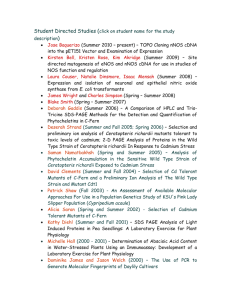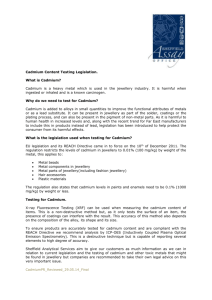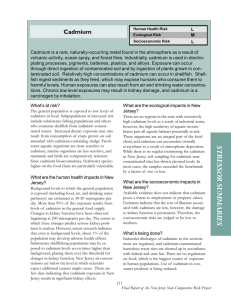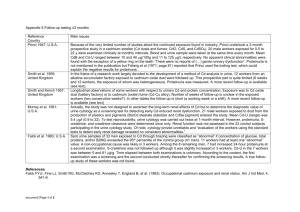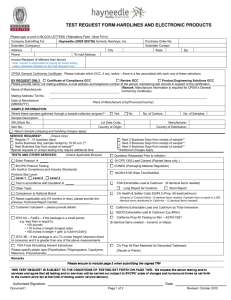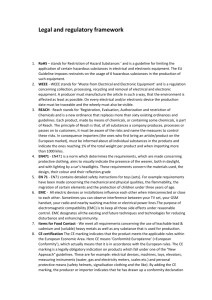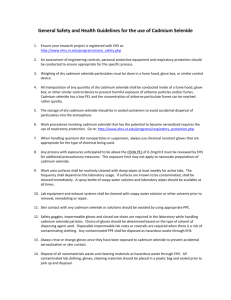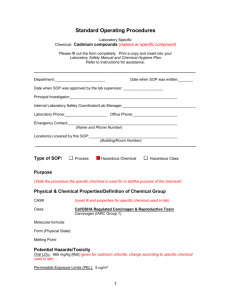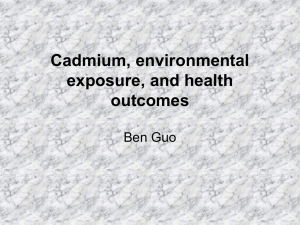Cadmium (Cd)
advertisement
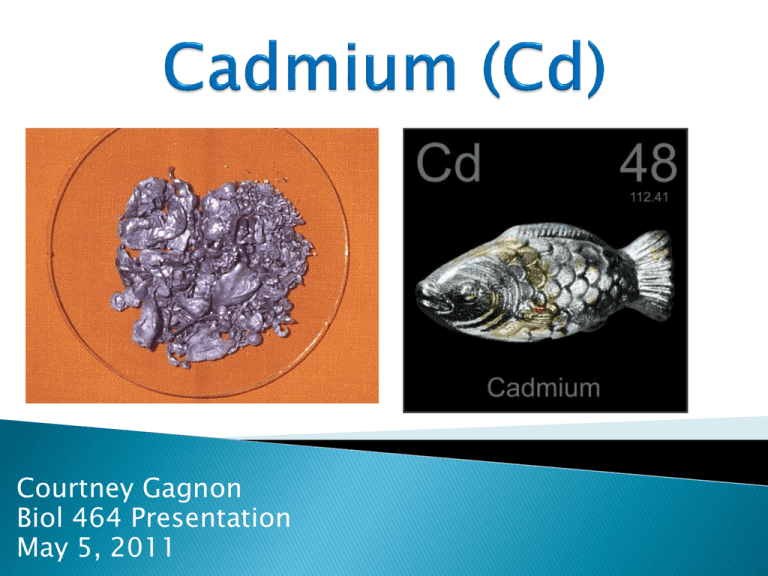
Courtney Gagnon Biol 464 Presentation May 5, 2011 Discovered in 1817 in Germany as an impurity in zinc carbonate Atomic number: 48 Melting point: 609.93° F Chemically similar to zinc and mercury Natural Abundances: Earth’s crust: 15x10-6 % Oceans: 5x10-9 % Humans: 7x10-5 % Semiconductor as cadmium sulfide that becomes more conductive when exposed to light Classic paint pigment popularly used by impressionist painters like Monet Anticorrosive plating (most popular use) Thin foil used in nuclear research facilities for use as radiation shielding. Ni-Cd batteries and Li-Cd batteries Present in P fertilizers used for crop production Solar panels Runoff during storm events ◦ Rain is slightly acidic from dissolved CO2 and leeches cadmium from metals ◦ Washed from crops treated with Cd-P fertilizers Release of wastewaters generated by anthropogenic sources Settlement of air particles on water that are polluted by cigarette smoke, road dust, burning plastics and wood. Accumulates in mud and microalgae Cadmium does not react with water Instead, it accumulates over time in bottom sediments Natural Radioisotopes ◦ ◦ 113Cd: Half life = 7.7x1015 years 116Cd: Half life = 2.9x1019 years Contamination starts at the level of microalgae , which bioaccumulates and biomagnifies at higher trophic levels The surface of microalgal cells is negatively charged and provides binding sites for metal cations Algae bioabsorb and bioconcentrate heavy metals from the aquatic environment: Cd2+ > Hg2+ > Cr6+ > Pb2+ > As5+ Cd concentrations were shown to cause 90% cell inhibition of microalgae at 5 mg/L. Lower concentrations caused a slow decline in biomass Cadmium concentration in fish (also meat and fruit): 0.005- 0.01 μg/g of dry weight. Shellfish contain higher concentrations. Dissolution of Cd-P in fertilizers increases with decreasing soil pH Half life in blood 75-128 days (fast component) to 716 years (slow component), in bone is 30 years, and in the kidney is 6-38 years. Accumulates in humans by contaminated food, coffee, and water, inhalation of contaminated air and cigarette smoke (20 μg/pack) The EPA calculated an inhalation unit risk estimate of 1.8x10-3 (μg/m3 ) The estimated lowest observed adverse effect level for a single oral dose is 19.5 μg/lb body weight Cadmium, once in the body, stays, probably for life, in the kidneys, the liver, bone and the blood vessels. As little as 2 μg daily absorbed and retained results in a body burden of 30 mg in 40 years Chronic intake of Cd over a long period of time most commonly cause kidney damage and weak bones The lungs and gastrointestinal tract are the two main routes of Cd to cause toxicity. Skin does not easily absorb cadmium. Cd is absorbed from the gastrointestinal tract by a transporter, DMT1 in the duodenum. Cd absorbed into circulation is taken up by the liver and bound to metallothionein (MT) where it is filtered in the kidney and almost completely reabsorbed in renal tubules. Only a small amount is absorbed into the body from the gut 10%, most of which is excreted in the urine. About half of Cd inhaled is retained, which is absorbed from the lungs. The kidney is the main organ affected by chronic Cd exposure and toxicity Cd2+ induces an increase in lipid peroxidation which can damage organs such as the liver, kidney, and testis. Cd directly inhibits Na-K channels Cd-MT is degraded in endosomes and lysosomes, which releases Cd2+ into the cytosol. Cd2+ accumulates in the mitochondria and inhibits the respiratory chain (by electron transfer). Results in production of reactive oxygen species (ROS) and mitochondrial disruption with the release of cytochrome c, causing cell death by apoptosis and necrosis Classified as a carcinogen, but it is hard to determine if due to high Cd concentrations, or from other toxins present in cigarettes Cd can induce autoantibodies to MT, which may interfere with Cd detoxification. Plants and algaes use the phytohormone, gibberellic acid (GA3 ) to metabolize Cd; however, it does not withstand strong toxic dosage (10-4 M). Exposure significantly decreases the cytochrome P450 side chain cleavage complex which catalyzes the biosynthesis of steroids Cd2+ induces oxidative stress by binding to sulfyhydryl groups of proteins and by depleting glutathione. Lipoic acid and selenium have been proven to reverse damage caused by Cd2+ on antioxidant defense mechanisms Cd exposure up-regulates MT production in the liver as a protective response, but once the MTproducing capacity is exhausted, tubular cells are damaged Urinary cadmium excretion is slow; however, it constitutes the major mechanism of elimination Hair has proven to be a vehicle of detoxification of substances from the human body because metal cations bind to the sulphur of keratin. Concentrations were up to 10 fold higher than levels found in blood and urine samples Bharavi, K., Reddy, A.G., Rao, G.S., Kumar, P.R., Prasadini, P.P. 2011. Prevention of cadmium bioaccumulation by herbal adaptogens. Indian J. Pharmacol. 43: 45-49. Available from: http://www.ijponline.com/text.asp?2011/43/1/45/75669 Falkowshka, M., Pietryczuk, A., Piotrowska, A., Bajguz, A., Grygoruk, A., Czerpak, R. 2011. The effect of gibberellic acid (GA3 ) on growth, metal biosorption and metabolism of the green algae Chlorella vulgaris (Chlorophyceae) Beijerinck exposed to cadmium and lead stress. Polish J. of Environ. Stud. 20(1): 53-59. Gel, F., Hernandez, A.F., Marquez, C., Femia, P., Olmedo, P., LopezGuarnido, O., Pla, A. 2011. Biomonitorization of cadmium, chromium, manganese, nickel and lead in whole blood, urine, axillary hair and saliva in an occupationally exposed population. Science of the Total Environment 409: 1172-1180. Johri, N., and Jacquillet, G., Heavy metal poisoning: the effects of cadmium on the kidney. Biometals 23: 783-792. Monteiro, C.M., Fonseca, S.C., Castro, P.M.L., Melcata, F.X. 2011. Toxicity of cadmium and zinc on two microalgae, Scenedesmus obliquus and Desmodesmus pleiomorphus, from Northern Portugal. J. Appl. Phycol 23: 97-103. Schroeder, M.D., Henry. 1974. The Poisons Around Us, Toxic metals in food, air and water. Found on: www.ithyroid.com Illinois Dept. of Public Health www.idph.state.il.us/cancer/factsheets.cadmium.htm

